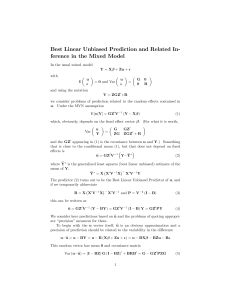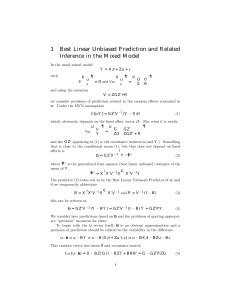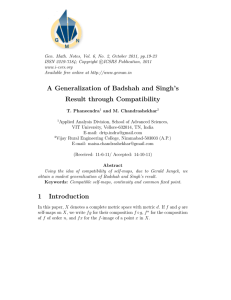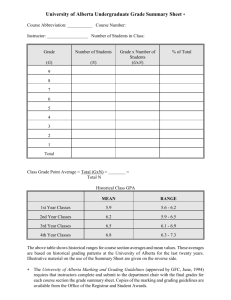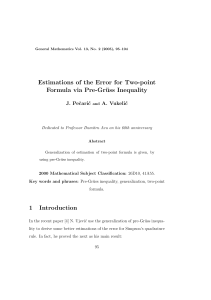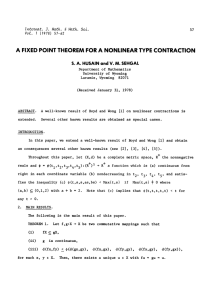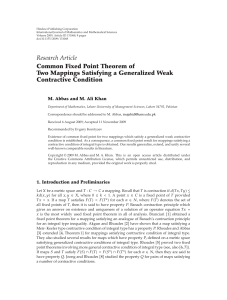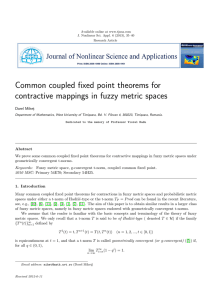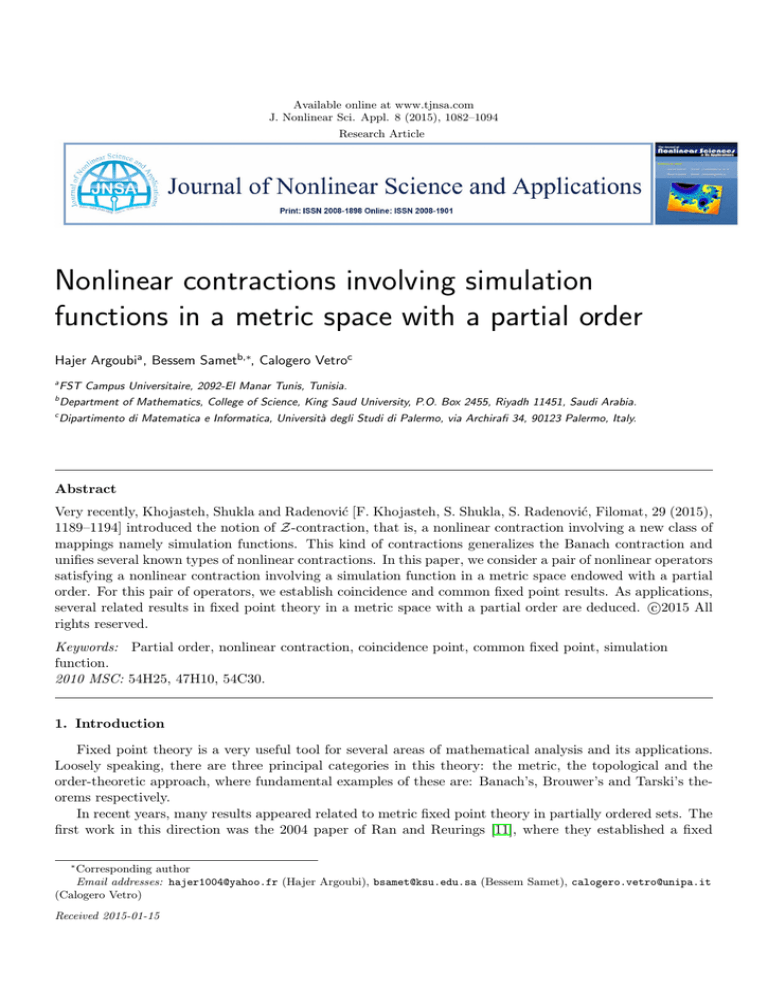
Available online at www.tjnsa.com
J. Nonlinear Sci. Appl. 8 (2015), 1082–1094
Research Article
Nonlinear contractions involving simulation
functions in a metric space with a partial order
Hajer Argoubia , Bessem Sametb,∗, Calogero Vetroc
a
FST Campus Universitaire, 2092-El Manar Tunis, Tunisia.
b
Department of Mathematics, College of Science, King Saud University, P.O. Box 2455, Riyadh 11451, Saudi Arabia.
c
Dipartimento di Matematica e Informatica, Università degli Studi di Palermo, via Archirafi 34, 90123 Palermo, Italy.
Abstract
Very recently, Khojasteh, Shukla and Radenović [F. Khojasteh, S. Shukla, S. Radenović, Filomat, 29 (2015),
1189–1194] introduced the notion of Z-contraction, that is, a nonlinear contraction involving a new class of
mappings namely simulation functions. This kind of contractions generalizes the Banach contraction and
unifies several known types of nonlinear contractions. In this paper, we consider a pair of nonlinear operators
satisfying a nonlinear contraction involving a simulation function in a metric space endowed with a partial
order. For this pair of operators, we establish coincidence and common fixed point results. As applications,
c
several related results in fixed point theory in a metric space with a partial order are deduced. 2015
All
rights reserved.
Keywords: Partial order, nonlinear contraction, coincidence point, common fixed point, simulation
function.
2010 MSC: 54H25, 47H10, 54C30.
1. Introduction
Fixed point theory is a very useful tool for several areas of mathematical analysis and its applications.
Loosely speaking, there are three principal categories in this theory: the metric, the topological and the
order-theoretic approach, where fundamental examples of these are: Banach’s, Brouwer’s and Tarski’s theorems respectively.
In recent years, many results appeared related to metric fixed point theory in partially ordered sets. The
first work in this direction was the 2004 paper of Ran and Reurings [11], where they established a fixed
∗
Corresponding author
Email addresses: hajer1004@yahoo.fr (Hajer Argoubi), bsamet@ksu.edu.sa (Bessem Samet), calogero.vetro@unipa.it
(Calogero Vetro)
Received 2015-01-15
H. Argoubi, B. Samet, C. Vetro, J. Nonlinear Sci. Appl. 8 (2015), 1082–1094
1083
point result, which can be considered as a combination of two fixed point theorems: Banach contraction
principle and Knaster-Tarski fixed point theorem. Further, several results appeared in this direction, we
mention [1, 2, 3, 4, 5, 7, 8, 9, 10, 13] and the references therein.
Very recently, Khojasteh, Shukla and Radenović [6] introduced the notion of Z-contraction, that is, a
nonlinear contraction involving a new class of mappings namely simulation functions. They studied the
existence and uniqueness of fixed points for Z-contraction type operators. This class of Z-contractions
includes a large types of nonlinear contractions existing in the literature. Thus, it is possible to treat several
fixed point problems from a unique, common point of view.
In [12], Roldán et al. studied the existence and uniqueness of coincidence points of a pair of nonlinear
operators satisfying a certain contraction involving simulation functions.
In this paper, we consider a pair of nonlinear operators satisfying a nonlinear contraction involving
a simulation function in a metric space endowed with a partial order. For this kind of contractions, we
establish coincidence and common fixed point results. As applications, several related results in fixed point
theory in a metric space with a partial order are deduced.
2. The class of simulation functions
The class of simulation functions was introduced by Khojasteh et al. in [6] as follows.
Definition 2.1. A simulation function is a mapping ζ : [0, ∞) × [0, ∞) → R satisfying the following conditions:
(ζ1 ) ζ(0, 0) = 0;
(ζ2 ) ζ(t, s) < s − t, for all t, s > 0;
(ζ3 ) if {tn }, {sn } are sequences in (0, ∞) such that limn→∞ tn = limn→∞ sn = ` ∈ (0, ∞), then
lim sup ζ(tn , sn ) < 0.
n→∞
The main result in [6] is the following.
Theorem 2.2. Let (X, d) be a complete metric space and T : X → X be a Z-contraction with respect to a
certain simulation function ζ, that is,
ζ(d(T x, T y), d(x, y)) ≥ 0, for all x, y ∈ X.
(2.1)
Then T has a unique fixed point. Moreover, for every x0 ∈ X, the Picard sequence {T n x0 } converges to this
fixed point.
Note that the condition (ζ1 ) was not used for the proof of Theorem 2.2. However, taking x = y in (2.1),
we obtain ζ(0, 0) ≥ 0. So if ζ(0, 0) < 0, then the set of operators T : X → X satisfying (2.1) will be empty.
Taking in consideration the above remark, we slightly modify the previous definition by removing the
condition (ζ1 ). So the following notion will be used throughout this paper.
Definition 2.3. A simulation function is a mapping ζ : [0, ∞) × [0, ∞) → R satisfying the conditions (ζ2 )
and (ζ3 ).
Clearly, any simulation function in the original Khojasteh et al. sense (Definition 2.1) is also a simulation
function in our sense (Definition 2.3), but the converse is not true, as we show in the following example.
H. Argoubi, B. Samet, C. Vetro, J. Nonlinear Sci. Appl. 8 (2015), 1082–1094
1084
Example 2.4. Let ζλ : [0, ∞) × [0, ∞) → R be the function defined by
(
1
if (s, t) = (0, 0),
ζλ (t, s) =
λs − t otherwise,
where λ ∈ (0, 1). Then ζλ satisfies (ζ2 ) and (ζ3 ) with ζλ (0, 0) > 0.
3. Coincidence and common fixed points via simulation functions
Let (X, d) be a complete metric space. We suppose that the set X is endowed with a partial order .
We recall the following definitions.
Definition 3.1 ([3]). Let f, g : X → X be two given mappings. We say that f is g-non-decreasing if
(x, y) ∈ X × X, gx gy =⇒ f x f y.
Definition 3.2. Let f, g : X → X be two given mappings. We say that x ∈ X
• is a coincidence point of f and g if f x = gx;
• is a common fixed point of f and g if x = f x = gx;
• is a fixed point of f if f x = x.
Now, we present our first main result in this paper.
Theorem 3.3. Let f, g : X → X be two given mappings. Suppose that the following conditions hold:
(i) f (X) ⊆ g(X);
(ii) g(X) is closed;
(iii) f is g-non-decreasing;
(iv) there exists x0 ∈ X with gx0 f x0 ;
(v) if {gxn } ⊂ X is a non-decreasing sequence (w.r.t. ) with gxn → gz in g(X), then gz g(gz) and
gxn gz, for all n ∈ N;
(vi) there exists a simulation function ζ such that for every (x, y) ∈ X × X with gx gy, we have
ζ (d(f x, f y), M (f, g, x, y)) ≥ 0,
where
d(gx, f y) + d(gy, f x)
.
M (f, g, x, y) = max d(gx, gy), d(gx, f x), d(gy, f y),
2
Then f and g have a coincidence point. Further, if f and g commute at their coincidence points, then f
and g have a common fixed point.
H. Argoubi, B. Samet, C. Vetro, J. Nonlinear Sci. Appl. 8 (2015), 1082–1094
1085
In order to prove Theorem 3.3, some lemmas are needed.
Lemma 3.4. Suppose that all the assumptions of Theorem 3.3 are satisfied. Let {xn } be a sequence in X
such that
gxn+1 = f xn , for all n ∈ N.
(3.1)
Suppose that gxn 6= gxn+1 for all n ∈ N. Then
lim d(gxn , gxn+1 ) = 0.
n→∞
Proof. At first, observe that from (iii) and (iv), we have
gx0 gx1 · · · gxn gxn+1 · · ·
(3.2)
It follows from (3.2) and (vi) that for all n ≥ 1, we have
0 ≤ ζ(d(f xn−1 , f xn ), M (f, g, xn−1 , xn ))
= ζ(d(gxn , gxn+1 ), M (f, g, xn−1 , xn )).
Moreover, for all n ≥ 1, we have
d(gxn−1 , gxn+1 )
M (f, g, xn−1 , xn ) = max d(gxn−1 , gxn ), d(gxn , gxn+1 ),
2
.
The triangle inequality yields
d(gxn−1 , gxn+1 )
≤ max {d(gxn−1 , gxn ), d(gxn , gxn+1 )} .
2
Thus
M (f, g, xn−1 , xn ) = max {d(gxn−1 , gxn ), d(gxn , gxn+1 )} , n ≥ 1.
Therefore, from condition (ζ2 ), we have
0 ≤ ζ (d(gxn , gxn+1 ), max {d(gxn−1 , gxn ), d(gxn , gxn+1 )})
< max {d(gxn−1 , gxn ), d(gxn , gxn+1 )} − d(gxn , gxn+1 ),
for all n ≥ 1. The above inequality shows that
M (f, g, xn−1 , xn ) = d(gxn−1 , gxn ), n ≥ 1,
which implies that {d(gxn−1 , gxn )} is a monotonically decreasing sequence of non-negative real numbers.
So there is some r ≥ 0 such that
lim d(gxn−1 , gxn ) = r.
n→∞
Suppose that r > 0. It follows from the condition (ζ3 ) that
0 ≤ lim sup ζ (d(gxn , gxn+1 ), d(gxn−1 , gxn )) < 0,
n→∞
which is a contradiction. Then we conclude that r = 0, which ends the proof.
Lemma 3.5. Suppose that all the assumptions of Theorem 3.3 are satisfied. Let {xn } be a sequence in X
such that (3.1) holds with gxn 6= gxn+1 for all n ∈ N. Then {gxn } is bounded.
H. Argoubi, B. Samet, C. Vetro, J. Nonlinear Sci. Appl. 8 (2015), 1082–1094
1086
Proof. Let us assume that {gxn } is not a bounded sequence. Then there exists a subsequence {xnk } of {xn }
such that n1 = 1 and for each k ∈ N, nk+1 is the minimum integer such that
d(gxnk+1 , gxnk ) > 1
and
d(gxm , gxnk ) ≤ 1, for nk ≤ m ≤ nk+1 − 1.
By the triangle inequality, we obtain
1 < d(gxnk+1 , gxnk ) ≤ d(gxnk+1 , gxnk+1 −1 ) + d(gxnk+1 −1 , gxnk )
≤ d(gxnk+1 , gxnk+1 −1 ) + 1.
Letting k → ∞ in the above inequality and using Lemma 3.4, we get
lim d(gxnk+1 , gxnk ) = 1.
k→∞
(3.3)
Using the triangle inequality, we get
1 < d(gxnk+1 , gxnk ) ≤ d(gxnk+1 , gxnk+1 −1 ) + d(gxnk+1 −1 , gxnk )
≤ d(gxnk+1 , gxnk+1 −1 ) + d(gxnk+1 −1 , gxnk −1 ) + d(gxnk , gxnk −1 )
≤ d(gxnk+1 , gxnk+1 −1 ) + d(gxnk+1 −1 , gxnk ) + 2d(gxnk , gxnk −1 )
≤ d(gxnk+1 , gxnk+1 −1 ) + 1 + 2d(gxnk , gxnk −1 ).
Letting k → ∞ in the above inequality and using Lemma 3.4, we get
lim d(gxnk+1 −1 , gxnk −1 ) = 1.
k→∞
(3.4)
Again, the triangle inequality yields
|d(gxnk+1 −1 , gxnk ) − d(gxnk , gxnk+1 )| ≤ d(gxnk+1 −1 , gxnk+1 ).
Letting k → ∞ in the above inequality, using Lemma 3.4 and (3.3), we obtain
lim d(gxnk+1 −1 , gxnk ) = 1.
k→∞
(3.5)
By a similar way, we have
|d(gxnk −1 , gxnk+1 ) − d(gxnk −1 , gxnk+1 −1 )| ≤ d(gxnk+1 , gxnk+1 −1 ).
Letting k → ∞ in the above inequality, using Lemma 3.4 and (3.4), we obtain
lim d(gxnk −1 , gxnk+1 ) = 1.
k→∞
(3.6)
Now, using Lemma 3.4, (3.3), (3.4), (3.5) and (3.6), we obtain
lim M (f, g, xnk+1 −1 , xnk −1 ) = 1.
k→∞
Using (vi), (3.2), (3.3), (3.7) and the condition (ζ3 ), we obtain
0 ≤ lim sup ζ d(gxnk+1 , gxnk ), M (f, g, xnk+1 −1 , xnk −1 ) < 0,
k→∞
which is a contradiction. This ends the proof.
(3.7)
H. Argoubi, B. Samet, C. Vetro, J. Nonlinear Sci. Appl. 8 (2015), 1082–1094
1087
Lemma 3.6. Suppose that all the assumptions of Theorem 3.3 are satisfied. Let {xn } be a sequence in X
such that (3.1) holds with gxn 6= gxn+1 for all n ∈ N. Then {gxn } is a Cauchy sequence.
Proof. Let
Cn = sup{d(gxi , gxj ) : i, j ≥ n}, n ∈ N.
From Lemma 3.5, we know that Cn < ∞ for every n ∈ N. Since {Cn } is a positive monotonically decreasing
sequence, there is some C ≥ 0 such that
lim Cn = C.
n→∞
Let us suppose that C > 0. By the definition of Cn , for every k ∈ N (k ≥ 1), there exists nk , mk ∈ N such
that mk > nk ≥ k and
1
Ck − < d(gxmk , gxnk ) ≤ Ck .
k
Letting k → ∞ in the above inequality, we get
lim d(gxmk , gxnk ) = C.
k→∞
(3.8)
By the triangle inequality, we have
|d(gxmk , gxnk ) − d(gxmk −1 , gxnk −1 )| ≤ d(gxmk , gxmk −1 ) + d(gxnk , gxnk −1 ).
Letting k → ∞ in the above inequality, using (3.8) and Lemma 3.4, we get
lim d(gxmk −1 , gxnk −1 ) = C.
(3.9)
lim d(gxmk −1 , gxnk ) = C
(3.10)
lim d(gxnk −1 , gxmk ) = C.
(3.11)
k→∞
Similarly, we have
k→∞
and
k→∞
Using Lemma 3.4, (3.9), (3.10) and (3.11), we obtain
lim M (f, g, xmk −1 , xnk −1 ) = C.
k→∞
(3.12)
By (vi), (3.8), (3.12) and the condition (ζ3 ), we get
0 ≤ lim sup ζ(d(gxmk , gxnk ), M (f, g, xmk −1 , xnk −1 )) < 0,
k→∞
which is a contradiction. Thus we have C = 0, that is,
lim Cn = 0.
n→∞
This proves that {gxn } is a Cauchy sequence.
Now, we are able to prove our main result given by Theorem 3.3.
Proof. At first, observe that if gxp = gxp+1 for some p ∈ N, then gxp = f xp , that is, xp is a coincidence
point of f and g. In this case, the existence of a coincidence point is proved. So, we can suppose that
gxn 6= gxn+1 for every n ∈ N.
Since g(X) is closed and (X, d) is complete, by Lemma 3.6, there exists some z ∈ X such that
gxn → gz as n → ∞.
(3.13)
H. Argoubi, B. Samet, C. Vetro, J. Nonlinear Sci. Appl. 8 (2015), 1082–1094
1088
Now, we show that z is a coincidence point of f and g. Suppose that d(gz, f z) > 0. For all n ∈ N, we have
d(gxn , f z) + d(gz, gxn+1 )
M (f, g, xn , z) = max d(gxn , gz), d(gxn , gxn+1 ), d(gz, f z),
.
2
Letting n → ∞ and using (3.13), we get
lim M (f, g, xn , z) = d(gz, f z) > 0.
(3.14)
n→∞
On the other hand, by (v), (vi), (3.13), (3.14) and the condition (ζ3 ), we have
0 ≤ lim sup ζ(d(gxn+1 , f z), M (f, g, xn , z)) < 0,
n→∞
which is a contradiction. Thus we have d(gz, f z) = 0, and z is a coincidence point of f and g.
Suppose now that f and g commute at z. Set
w = gz = f z.
Then
f w = f (gz) = g(f z) = gw.
By (v), we have
gz g(gz) = gw.
On the other hand,
M (f, g, w, z) = d(w, gw).
Suppose that d(w, gw) > 0. Using (vi) and the condition (ζ3 ), we obtain
0 ≤ ζ(d(f w, f z), M (f, g, w, z)) = ζ(d(w, gw), d(w, gw)) < 0,
which is a contradiction. Thus we have
w = gw = f w,
and w is a common fixed point of f and g. This ends the proof of Theorem 3.3.
If g is the identity mapping, we obtain from Theorem 3.3 the following fixed point result.
Theorem 3.7. Let f : X → X be a given mapping. Suppose that the following conditions hold:
(i) (x, y) ∈ X × X, x y =⇒ f x f y;
(ii) there exists x0 ∈ X with x0 f x0 ;
(iii) if {xn } ⊂ X is a non-decreasing sequence with xn → z, then xn z, for all n ∈ N;
(iv) there exists a simulation function ζ such that for every (x, y) ∈ X × X with x y, we have
ζ (d(f x, f y), M (f, x, y)) ≥ 0,
where
d(x, f y) + d(y, f x)
M (f, x, y) = max d(x, y), d(x, f x), d(y, f y),
2
Then {f n x0 } converges to a fixed point of f .
.
H. Argoubi, B. Samet, C. Vetro, J. Nonlinear Sci. Appl. 8 (2015), 1082–1094
1089
4. Coincidence and common fixed points via right-monotone simulation functions
Suppose now that ζ : [0, ∞) × [0, ∞) → R satisfies the following additional condition:
(ζ4 ) for every t ≥ 0, we have
s1 , s2 ≥ 0, s1 ≤ s2 =⇒ ζ(t, s1 ) ≤ ζ(t, s2 ).
In this case, we say that ζ is a right-monotone simulation function.
Example 4.1. Let ζ : [0, ∞) × [0, ∞) → R be the function defined by
ζ(t, s) = | sin s| − t, for all t, s ≥ 0.
Then ζ is a simulation function but it is not a right-monotone simulation function.
Example 4.2. Let ζ : [0, ∞) × [0, ∞) → R be the function defined by
ζ(t, s) = s −
t+2
t, for all t, s ≥ 0.
t+1
Then ζ is a right-monotone simulation function.
From Theorem 3.3, we can deduce various coincidence and common fixed point results via right-monotone
simulation functions.
Corollary 4.3. Let f, g : X → X be two given mappings. Suppose that the following conditions hold:
(i) f (X) ⊆ g(X);
(ii) g(X) is closed;
(iii) f is g-non-decreasing;
(iv) there exists x0 ∈ X with gx0 f x0 ;
(v) if {gxn } ⊂ X is a non-decreasing sequence (w.r.t. ) with gxn → gz in g(X), then gz g(gz) and
gxn gz, for all n ∈ N;
(vi) there exists a right-monotone simulation function ζ such that for every (x, y) ∈ X × X with gx gy,
we have
ζ (d(f x, f y), d(gx, gy)) ≥ 0.
Then f and g have a coincidence point. Further, if f and g commute at their coincidence points, then f
and g have a common fixed point.
Proof. Observe that
d(gx, gy) ≤ M (f, g, x, y),
for all x, y ∈ X. Since ζ is a right-monotone simulation function, then
ζ (d(f x, f y), d(gx, gy)) ≥ 0 =⇒ ζ (d(f x, f y), M (f, g, x, y)) ≥ 0.
Therefore the result follows from Theorem 3.3.
H. Argoubi, B. Samet, C. Vetro, J. Nonlinear Sci. Appl. 8 (2015), 1082–1094
1090
Similarly, we can deduce the following results.
Corollary 4.4. Let f, g : X → X be two given mappings. Suppose that the following conditions hold:
(i) f (X) ⊆ g(X);
(ii) g(X) is closed;
(iii) f is g-non-decreasing;
(iv) there exists x0 ∈ X with gx0 f x0 ;
(v) if {gxn } ⊂ X is a non-decreasing sequence (w.r.t. ) with gxn → gz in g(X), then gz g(gz) and
gxn gz, for all n ∈ N;
(vi) there exists a right-monotone simulation function ζ such that for every (x, y) ∈ X × X with gx gy,
we have
ζ (d(f x, f y), max{d(gx, f x), d(gy, f y)}) ≥ 0.
Then f and g have a coincidence point. Further, if f and g commute at their coincidence points, then f
and g have a common fixed point.
Corollary 4.5. Let f, g : X → X be two given mappings. Suppose that the following conditions hold:
(i) f (X) ⊆ g(X);
(ii) g(X) is closed;
(iii) f is g-non-decreasing;
(iv) there exists x0 ∈ X with gx0 f x0 ;
(v) if {gxn } ⊂ X is a non-decreasing sequence (w.r.t. ) with gxn → gz in g(X), then gz g(gz) and
gxn gz, for all n ∈ N;
(vi) there exists a right-monotone simulation function ζ such that for every (x, y) ∈ X × X with gx gy,
we have
ζ (d(f x, f y), max{d(gx, gy), d(gx, f x), d(gy, f y)}) ≥ 0.
Then f and g have a coincidence point. Further, if f and g commute at their coincidence points, then f
and g have a common fixed point.
Note that the above results (Corollaries 4.3, 4.4 and 4.5) can be established independently for any
simulation function that is not necessarily right-monotone.
H. Argoubi, B. Samet, C. Vetro, J. Nonlinear Sci. Appl. 8 (2015), 1082–1094
1091
Example 4.6. Let X = [0, ∞) be endowed with the metric d : X × X → R given by
(
0
if x = y,
d(x, y) =
max{x, y} if x =
6 y.
Now, consider the usual order of real numbers and define the mappings f, g : X → X by f x = x and
gx = 2x, for all x ∈ X. Clearly, by above definitions, conditions (i)-(v) of Corollary 4.3 hold true, with
x0 = 0. Next, let ζ : X × X → R be given by
ζ(t, s) = s −
t+2
t.
t+1
Then, we have
ζ(d(f x, f y), d(gx, gy)) = 2y −
2y(y + 1) − y(y + 2)
y2
y+2
y=
=
≥0
y+1
y+1
y+1
for every (x, y) ∈ X × X, with x ≤ y. Thus, by an application of Corollary 4.3, we get that f and g have a
coincidence point, say z = 0. Also, since f and g commute at z, then f and g have a common fixed point.
5. Applications
In this section, as applications, we obtain some results in fixed point theory in partially ordered metric
spaces via specific choices of simulation functions.
Let (X, d) be a complete metric space. We suppose that the set X is endowed with a partial order .
Corollary 5.1. Let f, g : X → X be two given mappings. Suppose that the following conditions hold:
(i) f (X) ⊆ g(X);
(ii) g(X) is closed;
(iii) f is g-non-decreasing;
(iv) there exists x0 ∈ X with gx0 f x0 ;
(v) if {gxn } ⊂ X is a non-decreasing sequence (w.r.t. ) with gxn → gz in g(X), then gz g(gz) and
gxn gz, for all n ∈ N;
(vi) there exists some k ∈ (0, 1) such that for every (x, y) ∈ X × X with gx gy, we have
d(gx, f y) + d(gy, f x)
d(f x, f y) ≤ k max d(gx, gy), d(gx, f x), d(gy, f y),
.
2
Then f and g have a coincidence point. Further, if f and g commute at their coincidence points, then f
and g have a common fixed point.
Proof. The result follows from Theorem 3.3 by taking as simulation function
ζ(t, s) = ks − t,
for all t, s ≥ 0.
H. Argoubi, B. Samet, C. Vetro, J. Nonlinear Sci. Appl. 8 (2015), 1082–1094
1092
Corollary 5.2. Let f, g : X → X be two given mappings. Suppose that the following conditions hold:
(i) f (X) ⊆ g(X);
(ii) g(X) is closed;
(iii) f is g-non-decreasing;
(iv) there exists x0 ∈ X with gx0 f x0 ;
(v) if {gxn } ⊂ X is a non-decreasing sequence (w.r.t. ) with gxn → gz in g(X), then gz g(gz) and
gxn gz, for all n ∈ N;
(vi) there exists a lower semi-continuous function ϕ : [0, ∞) → [0, ∞) with ϕ−1 (0) = {0} such that for
every (x, y) ∈ X × X with gx gy, we have
d(gx, f y) + d(gy, f x)
d(f x, f y) ≤ max d(gx, gy), d(gx, f x), d(gy, f y),
2
d(gx, f y) + d(gy, f x)
− ϕ max d(gx, gy), d(gx, f x), d(gy, f y),
.
2
Then f and g have a coincidence point. Further, if f and g commute at their coincidence points, then f
and g have a common fixed point.
Proof. The result follows from Theorem 3.3 by taking as simulation function
ζ(t, s) = s − ϕ(s) − t,
for all t, s ≥ 0.
Corollary 5.3. Let f, g : X → X be two given mappings. Suppose that the following conditions hold:
(i) f (X) ⊆ g(X);
(ii) g(X) is closed;
(iii) f is g-non-decreasing;
(iv) there exists x0 ∈ X with gx0 f x0 ;
(v) if {gxn } ⊂ X is a non-decreasing sequence (w.r.t. ) with gxn → gz in g(X), then gz g(gz) and
gxn gz, for all n ∈ N;
(vi) there exists a function ϕ : [0, ∞) → [0, 1) with limt→r+ ϕ(t) < 1 for all r > 0 such that for every
(x, y) ∈ X × X with gx gy, we have
H. Argoubi, B. Samet, C. Vetro, J. Nonlinear Sci. Appl. 8 (2015), 1082–1094
1093
d(gx, f y) + d(gy, f x)
d(f x, f y) ≤ ϕ max d(gx, gy), d(gx, f x), d(gy, f y),
2
d(gx, f y) + d(gy, f x)
.
max d(gx, gy), d(gx, f x), d(gy, f y),
2
Then f and g have a coincidence point. Further, if f and g commute at their coincidence points, then
f and g have a common fixed point.
Proof. The result follows from Theorem 3.3 by taking as simulation function
ζ(t, s) = sϕ(s) − t,
for all t, s ≥ 0.
Corollary 5.4. Let f, g : X → X be two given mappings. Suppose that the following conditions hold:
(i) f (X) ⊆ g(X);
(ii) g(X) is closed;
(iii) f is g-non-decreasing;
(iv) there exists x0 ∈ X with gx0 f x0 ;
(v) if {gxn } ⊂ X is a non-decreasing sequence (w.r.t. ) with gxn → gz in g(X), then gz g(gz) and
gxn gz, for all n ∈ N;
(vi) there exists an upper semi-continuous function η : [0, ∞) → [0, ∞) with η(t) < t for all t > 0 and
η(0) = 0 such that for every (x, y) ∈ X × X with gx gy, we have
d(gx, f y) + d(gy, f x)
d(f x, f y) ≤ η max d(gx, gy), d(gx, f x), d(gy, f y),
.
2
Then f and g have a coincidence point. Further, if f and g commute at their coincidence points, then f
and g have a common fixed point.
Proof. The result follows from Theorem 3.3 by taking as simulation function
ζ(t, s) = η(s) − t,
for all t, s ≥ 0.
Corollary 5.5. Let f, g : X → X be two given mappings. Suppose that the following conditions hold:
(i) f (X) ⊆ g(X);
(ii) g(X) is closed;
(iii) f is g-non-decreasing;
H. Argoubi, B. Samet, C. Vetro, J. Nonlinear Sci. Appl. 8 (2015), 1082–1094
1094
(iv) there exists x0 ∈ X with gx0 f x0 ;
(v) if {gxn } ⊂ X is a non-decreasing sequence (w.r.t. ) with gxn → gz in g(X), then gz g(gz) and
gxn gz, for all n ∈ N;
(vi) there exists a function φ : [0, ∞) → [0, ∞) with φ ∈ L1loc [0, ∞) and
Z ε
φ(u) du > ε,
0
for every ε > 0, such that for every (x, y) ∈ X × X with gx gy, we have
Z d(f x,f y)
d(gx, f y) + d(gy, f x)
φ(u) du ≤ max d(gx, gy), d(gx, f x), d(gy, f y),
.
2
0
Then f and g have a coincidence point. Further, if f and g commute at their coincidence points, then f
and g have a common fixed point.
Proof. The result follows from Theorem 3.3 by taking as simulation function
Z t
ζ(t, s) = s −
φ(u) du,
0
for all t, s ≥ 0.
Acknowledgements
The authors would like to extend their sincere appreciation to the Deanship of Scientific Research at
King Saud University for its funding of this research through the International Research Group Project No.
IRG14-04.
References
[1] R. P. Agarwal, M. A. El-Gebeily, D. O’Regan, Generalized contractions in partially ordered metric spaces, Appl.
Anal., 87 (2008), 109–116. 1
[2] V. Berinde, Coupled coincidence point theorems for mixed monotone nonlinear operators, Comput. Math. Appl.,
64 (2012), 1770–1777. 1
[3] L. Ćirić, N. Cakić, M. Rajović, J. S. Ume, Monotone generalized nonlinear contractions in partially ordered metric
spaces, Fixed Point Theory Appl., 2008 (2008), 11 pages. 1, 3.1
[4] J. Harjani, K. Sadarangani, Fixed point theorems for weakly contractive mappings in partially ordered sets, Nonlinear Anal., 71 (2009), 3403–3410. 1
[5] J. Jachymski, The contraction principle for mappings on a metric space with a graph, Proc. Amer. Math. Soc.,
136 (2008), 1359–1373. 1
[6] F. Khojasteh, S. Shukla, S. Radenović, A new approach to the study of fixed point theorems via simulation
functions, Filomat, 29 (2015), 1189–1194. 1, 2, 2
[7] V. Lakshmikantham, L. B. Ćirić, Coupled fixed point theorems for nonlinear contractions in partially ordered
metric spaces, Nonlinear Anal., 70 (2009), 4341–4349. 1
[8] J. J. Nieto, R. Rodriguez-Lopez, Contractive mapping theorems in partially ordered sets and applications to
ordinary differential equations, Order, 22 (2005), 223–239. 1
[9] A. Petrusel, I. A. Rus, Fixed point theorems in ordered L-spaces, Proc. Amer. Math. Soc., 134 (2006), 411–418.1
[10] S. Radenović, Z. Kadelburg, Generalized weak contractions in partially ordered metric spaces, Comput. Math.
Appl., 60 (2010), 1776–1783. 1
[11] A. C. M. Ran, M. C. B. Reurings, A fixed point theorem in partially ordered sets and some applications to matrix
equations, Proc. Amer. Math. Soc., 132 (2004), 1435–1443. 1
[12] A. Roldán, E. Karapinar, C. Roldán, J. Martı́nez-Moreno, Coincidence point theorems on metric spaces via
simulation functions, J. Comput. Appl. Math., 275 (2015), 345–355. 1
[13] B. Samet, C. Vetro, P. Vetro, Fixed point theorems for α-ψ-contractive type mappings, Nonlinear Anal., 75 (2012),
2154–2165. 1

